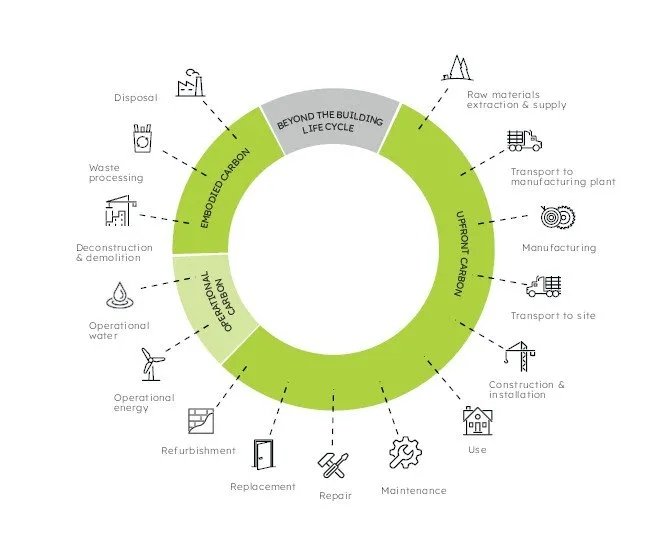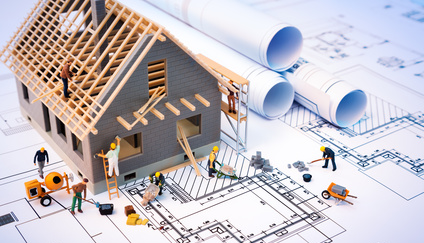
Sustainable Quantity Surveying: How to Measure Embodied Carbon in Construction Projects
Introduction
The construction sector is under increasing pressure to reduce its carbon footprint, and for good reason: nearly 11% of global greenhouse gas emissions come from embodied carbon—the emissions associated with materials and construction processes, not just building operation.
While much of the industry's focus has been on operational carbon (heating, cooling, and lighting), there’s now a growing shift toward tackling embodied carbon, especially in the early design and procurement stages.
This is where quantity surveying plays a pivotal role. At DQS Consulting, we integrate embodied carbon assessments into our cost planning and procurement strategies, helping our clients meet net-zero targets without compromising budgets or build quality.
What is Embodied Carbon?
Embodied carbon refers to the total greenhouse gas emissions associated with the production, transportation, installation, maintenance, and disposal of building materials.
It includes:
Raw material extraction
Manufacturing and processing
Transportation to site
Construction processes
Replacement and end-of-life impacts
Unlike operational carbon, embodied emissions are locked in before the building is even used, making early intervention essential.
The Role of Quantity Surveying in Embodied Carbon Assessment
As cost managers and procurement specialists, quantity surveyors are uniquely positioned to influence material selection, construction methods, and lifecycle strategies—all of which directly impact a project's carbon footprint.
At DQS Consulting, our QS services support embodied carbon reduction by:
Integrating carbon data into cost plans and BoQs
Using life cycle costing (LCC) to align environmental impact with long-term value
Collaborating with design teams to evaluate low-carbon material alternatives
Supporting clients in achieving BREEAM, LEED, or Net Zero Carbon goals
Related Read: BREEAM and LEED Certification: What QS Professionals Need to Know
How to Measure Embodied Carbon: A Step-by-Step Guide
Step 1: Establish the Project Scope and Carbon Goals
Determine whether you’re targeting embodied carbon only, or whole life carbon (including operational use).
Identify any certification frameworks or carbon reduction targets (e.g. RIBA 2030, LETI, UKGBC Net Zero).
Set a carbon budget—just like a cost budget, but focused on emissions.
Step 2: Collect Material Quantities from BoQs and BIM Models
Use Bills of Quantities (BoQ) or digital models to extract accurate material volumes.
Group materials into categories (e.g. concrete, steel, timber, insulation) for analysis.
💡 Tip: If BIM is being used, 5D models can link quantities directly with cost and carbon data.
Step 3: Apply Carbon Factors Using a Recognised Database
Multiply the quantity of each material by its embodied carbon factor (kgCO₂e per unit).
Use trusted databases such as:
ICE Database (UK)
One Click LCA
eTool
EC3 (Embodied Carbon in Construction Calculator)
Step 4: Calculate Embodied Carbon Totals Across Lifecycle Stages
Embodied carbon is typically broken down into RICS or EN15978 stages:
A1-A3: Raw material supply, manufacturing, and transport
A4-A5: Delivery to site and construction
B1-B7: Use and maintenance (sometimes included)
C1-C4: Demolition and end-of-life
D: Benefits and loads beyond the system boundary (e.g., reuse or recycling)
A full life cycle assessment (LCA) adds credibility to your measurement and supports compliance with green building certifications.
Best Practices for Quantity Surveyors Measuring Embodied Carbon
1. Collaborate Early with Design and Sustainability Teams
Quantity surveyors can advise on low-carbon alternatives before material selection is finalised.
Encourage early carbon benchmarking to keep reductions on track.
2. Integrate Carbon and Cost Planning Together
Use cost plans to identify high-impact materials (e.g. concrete, steel, aluminium).
Balance carbon reduction with cost efficiency through value engineering.
Related Read: How Quantity Surveying Can Reduce a Project’s Carbon Footprint
3. Choose Reused, Recycled or Locally Sourced Materials
Reduce emissions from transport and raw material processing.
Factor in supplier sustainability credentials during procurement.
4. Track and Report Carbon Progress
Include carbon metrics in cost reports, procurement schedules, and board-level updates.
Align with industry benchmarks, such as LETI’s embodied carbon targets (e.g. 300–400 kgCO₂e/m² for new offices).
Common Tools for Measuring Embodied Carbon
There are a number of digital tools and platforms available to help quantify embodied carbon in construction projects. These tools vary in complexity and scope but are united by a shared purpose: to make it easier for project teams to measure, track and reduce the environmental impact of materials and processes. Selecting the right tool depends on the project stage, available data, and sustainability goals.
Popular tools used across the UK construction industry include:
One Click LCA – A lifecycle assessment tool widely used for embodied carbon calculations, offering integrations with BIM and EPD databases.
EC3 (Embodied Carbon in Construction Calculator) – Developed by the Carbon Leadership Forum, this tool focuses on upfront carbon and material comparisons.
eToolLCD – A comprehensive LCA platform with features for detailed modelling and reporting aligned to international standards.
BRE IMPACT – A UK-specific database and toolkit aligned with BREEAM, supporting accurate assessments within BIM environments.
Athena Impact Estimator – A North American LCA tool that’s also applicable to UK projects with some localisation.
Tally – A Revit-integrated tool that enables designers and engineers to assess embodied carbon during early design phases.
IES IMPACT – Part of the IES Virtual Environment, this tool offers embodied carbon analysis as part of wider sustainability modelling.
Each of these tools plays a role in driving low-carbon design decisions by making embodied carbon visible, measurable, and actionable.
How DQS Consulting Supports Low-Carbon Projects
At DQS Consulting, we bring together carbon-conscious cost planning and sustainable procurement expertise to:
Build carbon budgets alongside cost budgets
Advise on low-impact materials and suppliers
Support BREEAM, LEED, and Net Zero compliance
Report and track embodied carbon performance across all RIBA stages
Whether you’re delivering a public sector framework or a private sector development, we help you stay on target for both budget and carbon goals.
Final Thoughts
Measuring and managing embodied carbon is essential for building a sustainable future—and it starts with the right data, tools, and advice.
With the right approach to quantity surveying, construction teams can make informed decisions that balance cost, performance, and environmental impact.
Ready to reduce embodied carbon in your next project? Get in touch with DQS Consulting today for expert quantity surveying services that deliver sustainability without compromise.
Related Reads:
Discover more about surveying
What is Quantity Surveying in Construction?
Find out more about what is quantity surveying in construction
What is a Quantity Surveying Course?
Find out more about what is a quantity surveying course.
How to Study Quantity Surveying
Find out more about how to study quantity surveying.
What is Quantity Surveying in Construction Economics?
Find out more about what is quantity surveying in construction economics.
Get in touch
Every construction project is unique which is why we tailor our quantity surveying services to your needs. From cost management to risk assessment and compliance, we deliver clear, sustainable solutions.
Get in touch today to discuss your project.









